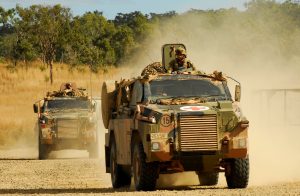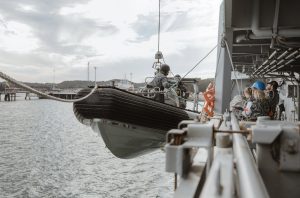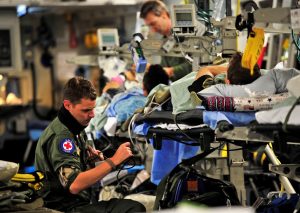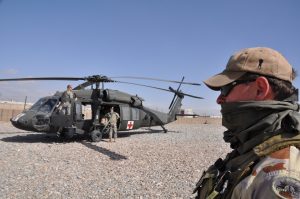Introduction
This article is the latest of a series regarding the role of occupational and environmental medicine in the ADF.1,2,3,4,5,6
These articles, as well as a recent Productivity Commission inquiry,7 indicate that high workplace illness and injury rates confirm the need to improve the management of hazards associated with ADF workplaces, with better emphasis on prevention. To this end, a submission by the Royal Australasian College of Physicians to the aforementioned inquiry advocated this would best be achieved by basing the ADF’s health services on a systems-based occupational health strategic model.8
Doing so would have to entail reassessing the fundamental inputs to capability9 for both Joint Health Command and Defence’s Work Health and Safety Branch. The current state of the ADF’s occupational and environmental health services, and the small number of specialist practitioners within the Australasian Faculty of Occupational and Environmental Medicine, suggests that a mature model would take 10–15 years’ sustained effort.10
This article expands on these papers, with respect to the application of a strategic-level systems-based occupational health model to the ADF’s casualty evacuation capabilities.
Definitional clarifications
The term ‘casualty evacuation’ (casevac) can be differentiated from ‘medical evacuation’ (medevac), in that unlike the former, medevacs use dedicated vehicles (whether road, sea or air),11 and are protected by the Geneva Protocols.12
In addition, for the purpose of this article, the term ‘dedicated’ refers to purpose-built and -operated medevac platforms, while ‘designated’ refers to platforms with multimission capabilities that can include conducting casevacs when required.
ADF overseas operations and other deployments requiring ADF casevac support
Table 1 describes the ADF’s current overseas operations as of 10 May 2019.
However, Table 1 does not include short-term recurrent operations such as GATEWAY (Australia’s contribution to the preservation of regional security and stability in the northern Indian Ocean and South China Sea), SOLANIA (Australia’s contribution to maritime surveillance within the Pacific Region), or RENDERSAFE (disposal of World War II-era explosive remnants from South Pacific island nations).13 It also does not include ‘one-off’ overseas operations in response to specific incidents, such as assisting the response to the Fukushima nuclear accident in 2011,14 the Indian Ocean search for MH370 in 2014,15 or Operation FIJI ASSIST following Typhoon Winston in 2016.16
Table 1 also excludes ADF members who undertake overseas deployments without being force-assigned to any of these operations. For example, approximately one-third of Navy’s 14 000 personnel are posted to ships at any one time for up to two years, of whom about a third (up to 1600 personnel), are at sea or visiting overseas ports. Only about 500 of these seagoing Navy personnel are force-assigned to the operations per Table 1.17 It is likely that Army and Air Force have significant numbers of their own personnel in similar circumstances.
It is therefore estimated that at present, strategic casevac support is routinely required for at least 3500 ADF personnel. However, even this figure does not include up to 1300 additional ADF members aboard each of Navy’s two Landing Helicopter Dock (LHD) ships, which would increase the number of personnel requiring strategic casevac support to over 6000, or well over double that per Table 1.18
While there are no numbers available regarding forward or tactical casevacs, there were approximately 70 ADF casevacs back to Australia in 2017, 20 per cent of which were perhaps from non-Table 1 operations and other deployments.19 It is therefore estimated that the ADF currently conducts about 20 strategic AMEs per thousand deployed members per year.
In addition to its own personnel, the ADF has also deployed overseas to evacuate civilian casualties, notably the 200220 and 200521 Bali bombings.
ADF operations and exercises within Australia requiring ADF casevac support
ADF personnel often undertake exercises and other activities within Australia that may require casevac support. For example, Exercise TALISMAN SABRE 201522 resulted in 48 strategic casevacs, while Exercise HAMEL 201623 had 5424. While these casevacs were for routine conditions, the 1996 midair collision between two Army Blackhawks during a routine training exercise at the High Range Training Area near Townsville, led to 18 fatalities and 12 casevacs.25 In addition, a main machinery space fire aboard HMAS Westralia in 1998, at the beginning of an otherwise routine non-exercise deployment from HMAS Stirling, resulted in four deaths and five casevacs ashore.26
Exceptions aside,27 ADF operations within Australia typically entail disaster relief tasks such as flood relief in Queensland in 201228 and bushfire relief in NSW in 2013;29 the largest such operation at present remains Operation NAVY HELP DARWIN after Cyclone Tracy in 1974.30 Although casevacs have usually not been required for participating ADF members during these operations, they have been conducted for assisted civilians,31,32,33,34 because unlike the ADF’s casevac services, civilian medevac organisations are not intended, and are therefore generally unable, to move large numbers of patients simultaneously.
Finally, a routine requirement exists to return ‘garrison’ personnel to their home locations when they are ill or injured elsewhere (typically during courses).Virtually all intra- and interstate ‘garrison’ patient transfers use regular public transport aircraft (with or without a medical escort),35 or civilian aeromedical providers such as the Royal Flying Doctor Service.36

Stretcher fit, commercial passenger aircraft.37 Note how one stretcher case uses the same space as six seats.
Casevac platforms
Casevac platforms can be characterised by the land, sea or air environments in which they operate.
Operational and exercise land ADF casevacs within Australia and overseas generally use dedicated off-road-capable wheeled38,39,40 or tracked41 ambulances vehicles, while ‘garrison’ land casevacs typically use dedicated Service or civilian road ambulances or patient transport vehicles.42

Bushmaster ambulance, Urban Operations Training Facility, Shoalwater Bay Training Area, Exercise TALISMAN SABRE 2009.43 Note the benign nature of the terrain in this instance.
Every RAN Fleet unit can conduct surface maritime casevacs using Rigid Hull Inflatable Boats (RHIBs)44 or General Purpose Inflatable Boats (GPIBs),45 while amphibious Fleet units also have organic landing craft.46,47 However, RHIBs and GPIBs are only marginally fit-for-purpose (especially for stretcher cases), while the scarcity and other high-priority demands on landing craft makes it is unlikely that they would ever be solely dedicated for casevacs. Furthermore, the significant weather and sea state limitations of all these platforms, and alternative means of moving casualties between ships (such as light jackstay), usually mean that if possible, forward and tactical maritime casevacs are best conducted by air.

Launching a RHIB, Unit Readiness Evaluation, HMAS Toowoomba, 2019.48 The difficulties, dangers and limitations associated with moving stretcher cases via this means should be apparent.
Ocean-going ships were used during both World Wars for strategic casevacs from overseas, and to move casualties between Australian ports.49 Extended transit times of up to three months meant they required comprehensive on-board treatment services. For example, although she was the smallest Australian hospital ship in WWII and was only intended to evacuate Army casualties from Port Moresby to Brisbane, MV Centaur still required 65 permanently embarked medical personnel, to staff 252 beds plus an operating theatre, dental surgery, laboratory and pharmacy for up to 18 days.50
By comparison, 252 stretcher cases can be evacuated over the same route today in seven C-17 sorties of 3 hours 15 minutes flight duration, each carrying up to 36 stretcher patients and 8–10 health staff, plus additional medical and aircrew personnel for fatigue management purposes.51,52,53 Although additional sorties would be required to move intensive care cases (maximum six per C-17, medical and nursing staff permitting) it should be remembered that such cases from either World War would not have survived long enough to require evacuation.

Strategic aeromedical evacuation from Germany in a RAAF C-17 Globemaster III, 2011.54 Note the amount of space required for one intensive care casualty.
The 1982 South Atlantic War led to the educational cruise liner SS Uganda being used as a hospital ship, and the Royal Navy’s hydrographic survey vessels Hecla, Herald and Hydra as ‘ambulance ships’ for medevacs from the South Atlantic to Montevideo in Uruguay. This was necessary because of the short range of the UK Task Force rotary-wing aircraft within the South Atlantic area of operations, and the non-availability of airfields capable of accepting fixed-wing aircraft until the Port Stanley airport had been recaptured.55 The mismatch between the huge distances within Australia’s area of direct security interest (up to one tenth of the Earth’s surface, or 51 million km2),56 and the limited range of the ADF’s rotary-wing casevac aircraft that cover this area, indicates that if no suitable fixed-wing airfields are available, this remains the case even in the 21st century.57
All three Services have a range of rotary- (Navy58,59 and Army60,61,62) and fixed-wing (Air Force63,64,65) aircraft, most of which can be fitted with a comprehensive range of stretcher fits and other medical equipment.66 However, other high-priority demands mean that they are rarely exclusively dedicated for casevac purposes.

Australian Army Special Forces tactical aeromedical evacuation using a US Army UH-60 Black Hawk, Task Force WOLFPACK, Tarin Kowt Afghanistan, 2010.67 Note the Red Cross marking indicating its dedicated medevac status: the ADF is unlikely to employ its own such aircraft for combat operations.
The plethora of ADF platforms that can be used for casevac purposes (especially for amphibious operations, where combinations of some or all of these assets may be employed anywhere along the casevac chain), and their non-dedicated (and sometimes not even designated) status, supports basing casevac management on a systems-based occupational health model that premises each casevac mission as a discrete workplace.
Casevac hazards
The environments in which these casevac platforms operate have their own occupational and environmental hazards. Examples regarding land casevacs include those associated with off-road terrain and on-road traffic,68 while surface maritime casevacs include the effects of weather and sea state among other seagoing hazards, 69 some of which are also shared with air casevacs in addition to other aviation hazards.70 Additionally, the lack of Geneva Protocol protection means casevacs can also face operational hazards from enemy action that may threaten the mission, the platform, the personnel and the casualties.71,72
In order to manage the risks posed by these hazards, the planning, conduct and monitoring of casevac missions is highly contingent on ADF health staff not only having the aforementioned high degree of clinical acumen (in particular advising when casevac is not required), but also a comprehensive understanding of each platforms’ capabilities and limitations, as well as the environments in which they operate. This requires dedicated training for the on-scene health staff who request casevacs, the headquarters health staff who assess each request and plan, implement and otherwise control casevac missions, and the health staff who provide the en route clinical care. Furthermore, all these health staff need to work closely with the crews who operate these platforms, and the non-health headquarters staff who command and control them.
These considerations all support basing casevac management on a systems-based occupational health model that premises each casevac mission as a discrete workplace.
Casevac training
While no formal land casevac training is provided for ADF health officers, medics from all three Services undergo such instruction during the ADF Medic’s Course, conducted via the Army Logistic Training Centre at Bandiana. Likewise, although there is no formal maritime casevac training, all Navy medics receive the same basic seamanship instruction as other entrants at the RAN Recruit School at HMAS Cerberus. Selected Navy medics also receive maritime casualty regulation instruction (see below) during the Clinical Manager’s Course at the RAN Medical School at HMAS Penguin. The RAN Medical School also provides instruction for selected non-health personnel on how to initiate casevacs, during their two-week Minor War Vessel Health Care Provider’s Course. Similar courses exist for Army special forces and other ADF personnel.
All Air Force and some Navy and Army medical officers undergo aviation medicine training at the Institute of Aviation Medicine, at RAAF Base Edinburgh. This training includes basic modules on the aviation medicine aspects of fixed-and rotary-wing aircraft casevacs. Selected medical officers undergo further aviation medicine training in the UK.
All Air Force health officers and medics undergo additional fixed-wing casevac training at the Health Operational Conversion Unit (HOCU) at RAAF Base Richmond. HOCU also provides a Rotary-Wing Aeromedical Evacuation Course for Navy and Army health personnel, using Army (and sometimes Navy) aircraft. However, this course is primarily focused on ensuring personnel safety when working in and around helicopters, rather than actual in-flight clinical care.
The limitations of simulation aids such as mock-up or permanently grounded aircraft, with respect to aviation hazards such as noise, wind blast, and proximity to rotors, propellers and jet exhaust, mean that all these courses still need actual aircraft on which to conduct at least some of the training.
The hazards associated with working around all these platforms, and the environments in which they operate, demonstrate the extent to which even clinical casevac training requires at least some occupational health awareness.
Casevac regulation
A key misconception within the general ADF population and the wider Australian community, is that military casevacs are only conducted for battle casualties and other medical emergencies. In fact, most ADF casevacs are conducted for non-urgent patients who are either unlikely to resume their normal duties per their operational mission within an acceptable timeframe, or require treatment that may not be particularly urgent, but is simply not available in situ.
In support of this assertion, a previous paper notes that 81 per cent of the 62 087 US military medical evacuations from the Middle East area of operations in the 10 years from October 2001 were for diseases and non-battle injuries, of which about half were musculoskeletal injuries, mental disorders and ill-defined conditions.73
The highly variable degree of patient acuity (hence levels of care required) therefore mean that the primary aim of an efficient and effective casualty evacuation system, is to move the right casualties, at the right time, in the right order, by the right means, to the right destination medical facilities, with the right level of en route clinical care. Casualty regulation ensures that casualties are evacuated directly to health facilities that can not only deal with the numbers they receive, but can also provide the appropriate treatment. The intent is to balance the rate of effort of both the evacuation and treatment systems, while minimising the number of times that each casualty has to be handled.74
These requirements further reinforce the extent to which a high degree of clinical acumen is required, not only by the ADF health staff who request and/or conduct casevac missions, but also the headquarters health staff who assess incoming casevac requests, and then plan, direct and otherwise control which patients move when, by what means, to which destination medical facility and with what level of en route care.
Hence, casualty regulation is far broader in scope than simply being an administrative function, particularly with respect to (again) clinical decision making as to when casevacs are not required. Balancing these clinical requirements against the aforementioned occupational, environmental and operational hazards reinforces the extent to which the scope of casualty regulation remains entirely consistent with a strategic-level systems-based occupational health model.
Implications
This paper has already explained why the need to premise each casevac mission as a discrete workplace should be based on:
- the plethora of available ADF land- sea- and air-casevac platforms and their non-dedicated (and sometimes not even designated) status
- how the operational, environmental and operational hazards change with each casevac mission
- the extent to which casualty regulation is far broader in scope than simply being an administrative function
- the extent to which clinical staff require at least some awareness of the occupational hazards associated with working around or in their particular casevac platform.
Furthermore, as previously indicated, it is estimated that the ADF presently conducts about 20 strategic AMEs per thousand deployed ADF members per year. This rate will vary depending on factors such as:
- The standard of medical pre-deployment personnel preparation.
- The range of clinical services (capabilities) and capacities (numbers) of the supporting deployed health assets.
- The casualty holding policy, which dictates how long patients are to be retained by the support health assets before either returning them to duty, or evacuating them.
All of these factors depend on the occupational, environmental and operational health risks of each exercise, operation or deployment, the assessment of which is an occupational and environmental health function, irrespective of whether or not it is formally recognised as such.
Another factor affecting strategic AME rates pertains to the deployability status of members with known pre-existing medical conditions. The author has previously highlighted the importance of applying a risk management approach that balances the medical and operational risks posed by deploying such personnel in the first place, against the less-well-acknowledged yet still significant adverse effects of preventing such members from deploying who can in fact be deployed.74 Applying this approach is likewise an occupational and environmental health function.
Conclusion
With ADF personnel arguably exposed to the most diverse range of occupational and environmental hazards of any Australian workforce, high rates of preventable workplace illness and injury indicate the need to improve the management of occupational and environmental health hazards, with better emphasis on prevention rather than treatment. This suggests the need for substantially revised fundamental inputs to ADF health capability, in order to base them on a genuinely holistic and sustainable systems-based occupational health strategic model.
Among other requirements, the ADF’s ability to undertake forward, tactical and strategic casevacs is dependent on platforms and deployable health personnel with the relevant clinical skills and equipment, which can evacuate Service and/or civilian patients, in the right order, by the right means, to the right destination medical facilities, with the right levels of en route care, seamlessly by land, sea, and or / air. This requires a risk management approach by the on-scene health staff and other personnel who request casevacs, the headquarters health staff who assess these requests and then plan, implement and otherwise control the responding mission(s), and the health staff who actually conduct them. All ADF health staff therefore require a comprehensive understanding of each platforms’ capabilities and limitations and the environments in which the platforms operate.
Such an approach is therefore consistent with, and should be based on, the aforementioned model.
Author
Dr Neil Westphalen graduated from Adelaide University in 1985 and joined the RAN in 1987. He is a RAN Staff Course graduate and a Fellow of the Royal Australian College of General Practitioners, the Australasian Faculty of Occupational and Environmental Medicine, and the Australasian College of Aerospace Medicine. He also holds a Diploma of Aviation Medicine and a Master of Public Health.
His seagoing service includes HMA Ships Swan, Stalwart, Success, Sydney, Perth and Choules.Deployments include DAMASK VII, RIMPAC 96, TANAGER, RELEX II, GEMSBOK, TALISMAN SABRE 07, RENDERSAFE 14, SEA RAIDER 15, KAKADU 16 and SEA HORIZON 17.His service ashore includes clinical roles at Cerberus, Penguin, Kuttabul, Albatross and Stirling, and staff positions as J07 (Director Health) at the then HQAST, Director Navy Occupational and Environmental Health, Director of Navy Health, Joint Health Command SO1 MEC Advisory and Review Services, and Fleet Medical Officer.
Commander Westphalen transferred to the Active Reserve in 2016.
Disclaimer
The views epressed in this article are the author’s, and do not necessarily reflect those of the RAN, or any of the other organisations mentioned.
Corresponding Author: Neil Westphalen, neil.westphalen@bigpond.com
Authors: N Westphalen 1,2
Author Affiliations:
1 Royal Australian Navy Reserve
2 Navy Health Service, C/O Director Navy Health






